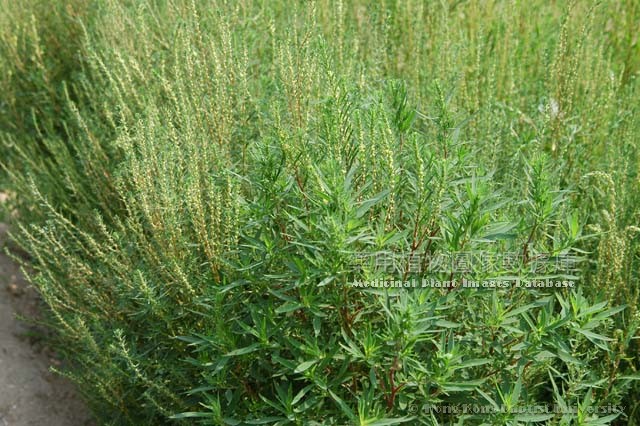|
Kochia scoparia (L.) Schrad.

|
English Name |
Summer-cypress, Belvedere, Broom Cypres |
|
Latin name |
Kochia scoparia (L.) Schrad. |
|
Family & Genus |
Chenopodiaceae, Kochia |
|
Description |
Annual herb, 0.50-1.5m tall. Stem upright, mostly branched, light green or light red, grown with short soft hairs. Leaf alternate; sessile; lamina narrow lanceolate or linear lanceolate, 2-7cm long, 3-7mm wide, tip short and gradually pointed, basal part wedge shaped, entire, upper surface green and hairless, lower surface light green, hairless or with short soft hairs; generally with 3 main veins; margin of spire with white long soft hairs, later gradually falling off. Flower single or 2grown in leaf axil, gathered into sparse spikes; sometimes with rusty long soft hairs below the flowers; flower small, miscellaneous; yellowish green, perianth 5 pieces, nearly spherical, basal part accrete, dorsal part grown with triangular transverse processes or wings in fruiting period, sometimes nearly fan shaped; stamens 5, filament filamentous; style extremely short, stigma 2, filamentous. Utricle flatly spherical, pericarp and seed distinct, embraced in perianth. Seed 1, flatly spherical, blackish brown. Flowering: June to September, fruiting: August to October. |
|
Distribution |
Growing on deserted fields, paddy fields and roadsides. Can be cultivated in gardens. Distributed in all parts of China. The medicinal materials are mainly produced in Jiangsu, Shandong, Henan, Hebei and etc. |
|
Part Used |
Medical part: fruits and young stem leaves. Chinese name: fruits: Difuzi. Young stem leaves: Difumiao. |
|
Harvest & Processing |
Fruits: sliced whole plant in autumn, sundried, knocked the fruits, and removed impurities, for future use. Young stem leaves: cut young stem leaves in spring and summer, washed, used fresh or sundried. |
|
Chemistry |
Fruits mainly contains oleanolic acid, {3-O-[β-D-xylopyranosyl 1→3 β-D-glucuronopy-ranosyl]-oleanolic acid}, n-triacontanol, and 20-hydroxy-24-methyleneecdysone. Tender stem contains harman, harmine and elements like Ca, Mg, Fe, Zn, Cu, and P, etc. |
|
Pharmacology |
Bacteriostatic, and blood-sugar-lowering. |
|
Properties & Actions |
Fruits: bitter, cold. Tender stem leaves: bitter, cold.Fruits: clearing heat for inducing diuresis, dispersing wind for stopping itching. Young stem leaves: clearing heat-toxin, disinhibiting urine and freeing strangury. |
|
Indications & Usage |
Fruits: difficulty in micturition, stranguria with turbid urine, leukorrhea, hematodiarrhoea, bastard measles, eczema, sarcoptidosis, skin itching, sores. Tender stems and leaves: dysentery with red and white feces, diarrhea, painful stramgutia, astringent pain induced by conjunctival congestion, night blindness, red swellings on skin due to wind-heat, ulcer and scabies.Fruits: oral administration: decocting, 6-15g; or made as pills or powders. External application: appropriate amount, decocted for washing. Young stem leaves: oral administration: decocting, 30-90g. External application: appropriate amount, decocted for washing; or extracted juice to apply by pounding. |
|
Examples |
1. Nephritis and edema: summer-cypress seed 10g, common ducksmeat 8g, common scouring 6g, white mulberry root bark 10g. Decoct in water, remove residues, 3 times a day.
2. Erysipelas: summer-cypress seed, flos lonicerae, common chrysanthemum 30g each, catnip, divaricate saposhnikovia root 15g each. Decoct in water and swallow.
3. Rheumatic arthralgia, scanty urine: difu seedling 12g. Decoct in water and swallow.
4. Headache: difu seedling, burn horse stool to ash, pestle together. And apply to head top. |
| Link to |
 Chinese Medicinal Material Images Database Chinese Medicinal Material Images Database
 Chinese Medicine Specimen Database Chinese Medicine Specimen Database
|
|

